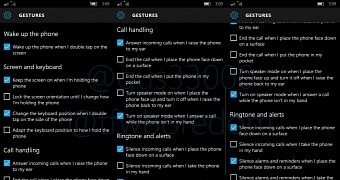New screenshots that reached the web the past weekend show a long list of gestures that were supposed to be offered on Microsoft’s Windows phones, but which, for some reason, never made it to devices, remaining just a dream for users who put their hopes on this platform.
As you can see in the picture included in the article (via @tfwboredom and @gus33000), there were quite a lot of gestures that Microsoft planned to offer on Windows devices, and while it’s not known why exactly the company decided to give up on them, there’s no doubt they would have substantially improved the experience with Windows phones, bringing them closer to Android and iOS rivals.
The double-tap-to-wake feature was part of this series of gestures, but in the end, it only arrived on the Lumia 950 and 950 XL with a firmware update a few months after launch, mostly because Microsoft had to make it available separately after giving up on the entire pack.
Other gestures
On the other hand, some of the gestures that the company abandoned were really useful, such as keeping the screen on when the owner holds the phone in hand. This bypassed the screen timeout, so as long as they were holding the phone, the screen remained on all the time.
There were also gestures for answering calls when the phone was raised to the ear, but also to end the call when the device was put face down on a surface or in the pocket. Microsoft even wanted to offer options to silence incoming calls when the phone was taken in hand or when the device was placed face down on a flat surface.
Unfortunately, not only that these gestures didn’t make it to Windows phones but there’s also a very small chance to ever see them becoming available for those who are still sticking with the platform.
The next phone on Microsoft’s roadmap could be the Surface Phone, if it indeed exists, and there’s no doubt that gestures like these would make it a more advanced piece of technology. For the moment, however, what we have is a collapsing mobile platform that Microsoft itself seems to be leaving behind for no clear reason.

 14 DAY TRIAL //
14 DAY TRIAL //